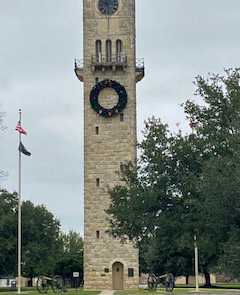I had reason to visit Fort Sam Houston today to pick up a set of prescriptions, at the new and vastly expanded BX mall, going through that one back gate where Harry Wurzbach dead-ends, after wandering past the military cemetery, the golf course and the Towers at Park Lane. It’s been a familiar haunt to me for years, even if I was never assigned there, or had reason to go to any offices when I was active duty. It was an open post back then so wide-open that it was only embarrassment that kept the Fort Sam EM/NCO club from being listed as off-limits to Air Force personnel. (There was, according to scuttlebutt, a dissolute and faintly dangerous element which used to hang out at that club.) I used to take a short-cut through the post on North New Braunfels to circumvent traffic jams on the Pan-Am Highway, when I had to drive through to Lackland AFB from where I lived on the north-east side of town. I was basically familiar with the older part; the stately red-brick Victorian senior officer-housing mansions along the northern and western side of the monumental, L-shaped parade ground, and the series of enormous three-story neo-Spanish Colonial style tile-roofed administration buildings and barracks which lined the opposite side. The mansions along “colonel’s row” always looked well kept, but in the few years after I retired, some of the older buildings began looking pretty ragged, decrepit even. I sometimes wondered if the Army had given up on painting them altogether, trimming shrubbery and pulling up weeds in the lawns around. Part of the peace dividend, I guessed.
For the Army it was a chance to start afresh, building exactly what they needed; generous warehouse space to store Army supplies brought up from Galveston and other coastal ports, offices for the supply sergeants and officers to work in, facilities to care for the horses, and the soldiers, and their families. A birds-eye map of San Antonio done in the 1880s clearly shows the original Fort Sam establishment; a single structure called the Quadrangle, a range of two-story buildings around an open courtyard adorned at one end with an ornate clock tower. The Quadrangle also served as an open-air prison in 1886. Geronimo, the last of the fighting Apache chiefs and some of his warrior band were held in the quadrangle for 40 days, while the federal government decided what to do with him. It’s only a legend that the small herd of tame deer currently living in the Quadrangle are those descended from a herd provided to Geronimo’s band as part of their ration issue.
By the turn of the last century, Fort Sam was the second largest military post in the United States. Practically every Army officer serving between the 1880s through World War II passed through Fort Sam at one time or another. Teddy Roosevelt’s “Rough Riders” rendezvoused and trained there before shipping to Cuba to charge up San Juan Hill. Whenever I pass by the open stretch of the parade ground, I am reminded that it was on that patch of level, open ground that then-Lieutenant Benjamin Foulois of the Signal Corps took off in a 1909 Wright Flyer, dubbed “Army Airplane #1” for a series of demonstration flights in 1910 four takeoffs, three successful landings, the series concluded with a crash. Lt. Foulois was, for an interesting early period in military aviation, the entire Air Corps/Air Force. Fort Sam also supplied the men and material for General John “Black Jack” Pershing’s expedition into Mexico, chasing after Pancho Villa in 1916. At the very far end of the parade ground is the old Brooke Army Medical Center (built in 1936), formerly the Station Hospital, replaced in the 1990s with an even larger and more splendid complex to the east of Fort Sam. Dwight Eisenhower met and married his wife, Mamie Dowd, while stationed at Fort Sam as a young lieutenant. General Billy Mitchell was assigned to Fort Sam after being court-martialed and demoted. At the end of WWII training of Army medical personnel was consolidated there, and military medical training for all the other armed services was moved to Fort Sam more than a decade ago. This makes it a very busy training facility; it is a showplace for military medicine, which is the reason that I go there for regular visits like today.
I have read that if the post is ever closed, and all facilities revert to the city of San Antonio (like the Presidio in San Francisco) that the stock of historic buildings in the city inventory would double right then and there. Most of those buildings are still in use, though at present, only the Quadrangle is open to the general public. But there are two museums, also open to the public, that between them give a very good idea of the scope of Fort Sam’s history and present missions: The Fort Sam Houston Museum, and the US Army Medical Department Museum.


I visited the Burn Center at Brooke in the 60s. At the time it was #1 and LA County Hospital was #2 in the world. A professor wanted me to go into burn care but I wasn’t having it. It is mostly plastic surgery anyway.
I recently went to my local Air Force base (hadn’t been there for years) and drove around. I can attest to the base looking a bit shabbier than I remember.
During the Obama years, there was tremendous pressure to downsize. So one Air Force response was to eliminate the civil engineering squadrons at most bases, and centralize all things CE at one remote agency. So if you need a sidewalk repaired, you dial an 800 number, someone writes down the problem, and after a while, an off-base contractor will eventually fix the sidewalk. Ditto with maintenance on family housing. So there’s no one local that a base commander can reach out and choke if things need fixed.
The Air Force was originality going to contract out all are infrastructure maintenance (and the base fire department too) until someone reminded them they needed to retain some CE and fire capability to support overseas bare-base operations. Oh.
All the golf course were closed years ago, to save money.
Something similar may account for Fort Sam looking a bit decrepit.
OD: “I can attest to the base looking a bit shabbier than I remember.”
Interesting in a world in which the budget for the US Armed Forces has been going up significantly over the years and the number of bases (at least in the Continental US) has been going down. The Man from Mars might expect this would result in more money for each remaining base, and therefore an improving standard of maintenance. So where is the taxpayer’s money being wasted or purloined — apart from Zelensky’s Ukraine?
One thought is that US managerial types (and senior military officers these days are managers, not leaders) really don’t like dealing with people. In most organizations, managers are not selected for their charisma and ability to motivate their subordinates. The result is that managers insulate themselves from the productive human being workers by outsourcing everything they can — then they only have to deal with their peer managers at the outsourcing supplier.
There have even been mutterings that much of the motivation for executives outsourcing productive industry to China, India, Mexico (leaving the US an increasingly de-industrialized Third World country) was to avoid having to deal with workers rather than to take advantage of low cost labor elsewhere.
Almost two decades ago I was one of the 5th Army Operations Center team chiefs. We ran 8-hour shifts that rotated around the clock every few weeks. In the key box of the ops center was the key to the clock tower (#27 IIRC). Late at night, or on Sundays, I, as the senior individual, would take it upon myself to get the key and go out to the tower as I figured it was important to verify security. Well, as long as I had the door open, I might as well take the stairs up (and the final vertical ladder to where the clock is mounted). Very nice view from up there and very old graffiti in and on the walls going back to shortly after the tower was built.
Be sure to check out the plaque in the sally port; President Ulysses S. Grant and General of the Army William T. Sherman. They fought together at the Battle of Shiloh which almost ended in Grant’s resignation. Grant stuck it out and he and Sherman rose in the ranks together.
The large houses on “Staff Officer Road” are indeed, quite large and very nice on the inside while I was there. In some of the buildings, I was slightly in awe of learning the names of the Soldiers who had stayed in them and who later rose to 2, 3, 4, and even 5-star command.
FWIW, long-time lurker but I make it a point to stop by regularly. Excellent and insightful posts and learned commenters.
Fort Sam was looking very shabby, in the late 1990s – I still needed to ferry my daughter to her high school then, and when she was a poolee for the Marines, she was working out at the post gym, so that was when I noted how run-down many of the older and unused buildings were. The old BAMC building was vacant – I think they used it for urban combat training exercises a number of times. The post got better maintained, post 9-11 and the build-up for the Iraq War. There were a lot of new buildings, and renovations of the old hospital building (which is said to be haunted); now it is repurposed as HQ for US Army South. The new BAMC – which now serves as central hospital for military and one of the main trauma centers for the area – that got expanded, and expanded again. A whole new extension, a parking garage, several new Fisher Houses, and a state-of-the-art rehab facility.
I had heard that Ft Ord was the 2nd largest base – after Pendleton? I’ll have to look them up. I get an eerie feeling when I go to the Monterey Historic Races via the back way and pass a few miles of boarded up Army buildings – 1000s of acres are fenced off with danger signs – it was a Morter range with untold unexploded ordnance., . I had basic training there.
Then too, drive though Mare Island near Vallejo – once a huge Navy base. I’d like to see Ft Wolters near Midland TX , during Vietnam every Army helicopter pilot – or most – went though Wolters and after the war it was abandoned. Today some is an industrial park, I believe.
I was told Teddy Roosevelt recruited his Rough Riders at the bar of the Menger Hotel in San Antonio – with by the Alamo. It is a beautiful hotel and I will have to stay there next time I am that way.
Ft. Wolters was near Mineral Wells, not Midland.
The reason the quarters look shabby on any Army base is because the Army no longer controls those buildings. Many years ago the Army and the other Services I believe, sold those quarters to a civilian company that agreed to build new housing if they could have a 50 year contract. The houses can now be “rented” by service members or anyone that can get on to the base/post. The company agrees to maintain the old houses, in some cases like here at Ft. Leavenworth, or tear down and replace them with new houses or expand the number of houses if necessary. That frees up money within the military budgets and makes it purely a transaction between the contracted company and the service member. One of the results is that the quarters look much shabbier today then they ever did in the past.